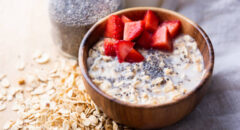
High cholesterol is a growing concern, with millions of people struggling to keep their levels in check. While medication can help, diet is the best way to manage cholesterol naturally. The good news? You don’t have to give up flavor to make heart-healthy choices!
Small changes in your everyday meals can lead to big improvements in your heart health. By making simple swaps, you can enjoy delicious food while lowering cholesterol and improving overall well-being. Here are five easy food swaps that keep your taste buds happy and your heart healthy.
1. Switching from Butter to Avocado or Olive Oil
Why It Matters
A study published in April 2021 in the journal BMC Medicine showed that the risk for cardiovascular disease was higher for people who ate a diet high in processed sugar, butter, and low-fiber bread and low in fruits and vegetables. Butter is high in saturated fat, raising LDL (“bad” cholesterol) and increasing the risk of heart disease. While fat is essential in a balanced diet, the type of fat you consume is crucial. Replacing butter with healthier fats—like avocado or olive oil—helps lower bad cholesterol and increase HDL (“good” cholesterol).
Healthy Swaps
- Use mashed avocado instead of butter on toast – Avocados are creamy and packed with heart-healthy monounsaturated fats. They also contain fiber and potassium, which support cardiovascular health.
- Cook with olive oil instead of butter – Olive oil is rich in antioxidants and anti-inflammatory properties. It is great for sautéing vegetables, drizzling over salads, or even baking.
- Try nut butters instead of butter – Almond butter and peanut butter provide healthy fats and protein while adding a delicious, nutty flavor to toast, oatmeal, or smoothies.
Flavor Boosting Tip:
To enhance the taste of avocado toast, try adding sliced tomatoes, red pepper flakes, or a squeeze of lemon juice. For olive oil, infuse it with garlic or herbs like rosemary and basil to add depth to your dishes.
RELATED: 3 Easy Swaps for a Healthier Heart
2. Choosing Whole Grains Over Processed Carbs
Why It Matters
Refined grains like white bread, white rice, and pastries have been stripped of their fiber, making them spike blood sugar levels and contribute to higher cholesterol over time. Whole grains, on the other hand, contain fiber that helps remove excess cholesterol from the bloodstream.
Healthy Swaps
- Switch to whole-grain bread instead of white bread – Whole grains provide more fiber and nutrients, keeping you fuller longer and supporting healthy cholesterol levels.
- Opt for brown rice, quinoa, or farro instead of white rice – These grains are nutrient-dense, high in fiber, and packed with plant-based protein.
- Choose whole-grain pasta instead of white pasta – Whole-wheat pasta has a slightly nutty flavor and provides more fiber to support digestion and heart health.
Flavor Boosting Tip:
Cook quinoa or brown rice in vegetable broth instead of water to add depth and savoriness. Add fresh herbs, garlic, or a squeeze of citrus juice for extra flavor.
3. Using Herbs & Spices Instead of Excess Salt
Why It Matters
Excess sodium can lead to high blood pressure, increasing heart disease risk. While salt does enhance flavor, relying too much on it can be harmful. The good news? Herbs and spices offer a natural way to boost flavor without raising cholesterol or blood pressure.
Healthy Swaps
- Use garlic and onion powder instead of salt – These add a savory kick to dishes without the negative effects of sodium.
- Try turmeric and black pepper for anti-inflammatory benefits – Turmeric contains curcumin, a powerful antioxidant that supports heart health.
- Use lemon juice or vinegar for a natural flavor boost – A splash of citrus or vinegar can add brightness and tanginess to meals without salt.
- Experiment with fresh herbs like basil, cilantro, or parsley – These bring fresh, vibrant flavors to salads, soups, and grilled dishes.
Flavor Boosting Tip:
Create your salt-free seasoning blend with paprika, garlic powder, onion powder, black pepper, and dried herbs like oregano and thyme. This mix works great on roasted vegetables, chicken, and seafood.
4. Healthy Protein Alternatives to Red Meat
Why It Matters
Red meat, especially processed meats like bacon and sausage, is high in saturated fat and cholesterol, which can raise LDL levels and increase the risk of heart disease. While meat is a good source of protein, choosing leaner, plant-based alternatives can improve cholesterol levels without sacrificing taste. Fatty fish have the advantage of containing omega-3 fatty acids, which have been shown to lower your risk of heart disease or stroke.
Healthy Swaps
- Opt for fatty fish instead of beef – Salmon, mackerel, and sardines are rich in omega-3 fatty acids, which help reduce inflammation and support heart health.
- Try plant-based proteins like lentils, beans, and chickpeas – These are packed with fiber, which helps lower cholesterol and improve digestion.
- Choose skinless poultry over red meat – Chicken and turkey are leaner options that provide protein without excessive saturated fat.
- Use tofu or tempeh for a meatless protein alternative – These plant-based proteins absorb flavors well and provide a satisfying texture in stir-fries, soups, and curries.
Flavor Boosting Tip:
Marinate tofu or tempeh in a mix of soy sauce, garlic, and ginger for added flavor. Roasting chickpeas with smoked paprika and cumin for plant-based proteins can create a crunchy, flavorful snack or salad topping.
RELATED: The 3-Day Cholesterol Reset: What to Eat & Avoid to See Instant Improvements
5. Replacing Sugary Drinks with Natural Infused Water
Why It Matters
Sugary beverages like soda, sweetened teas, and energy drinks are major contributors to high cholesterol and weight gain. They cause blood sugar spikes and increase triglycerides, which harm heart health. Cutting back on these drinks can significantly improve cholesterol levels and overall health.
Healthy Swaps
- Drink infused water instead of soda – Adding fruits, herbs, or cucumber to water gives it a refreshing taste without added sugars.
- Opt for herbal teas instead of sweetened iced tea – Herbal teas like hibiscus, green tea, and chamomile provide antioxidants and support heart health.
- Make homemade flavored sparkling water – Mix sparkling water with fresh citrus slices or a splash of natural fruit juice for a healthier alternative to soda.
- Blend smoothies with natural sweeteners like dates or bananas – If you’re craving something sweet, a smoothie with whole fruits can satisfy your taste buds without artificial sugars.
Flavor Boosting Tip:
Try infusing water with lemon, mint, and cucumber for a cooling effect. For a tropical twist, use pineapple and basil. Try a warm cup of water with lemon and honey to replace your morning orange juice.
Lowering cholesterol doesn’t mean sacrificing delicious food. These simple swaps allow you to enjoy rich, flavorful meals while protecting your heart. Whether switching from butter to avocado, replacing red meat with plant-based proteins, or opting for whole grains, every small change makes a difference.
The best part? These swaps aren’t just good for your heart—they make meals more exciting and enjoyable! Try incorporating one or two swaps at a time, and soon, you’ll develop habits that support long-term heart health.
Your journey to better cholesterol levels starts with your choices today—so why not make them healthy and flavorful?









